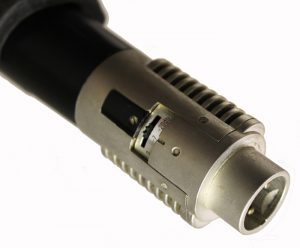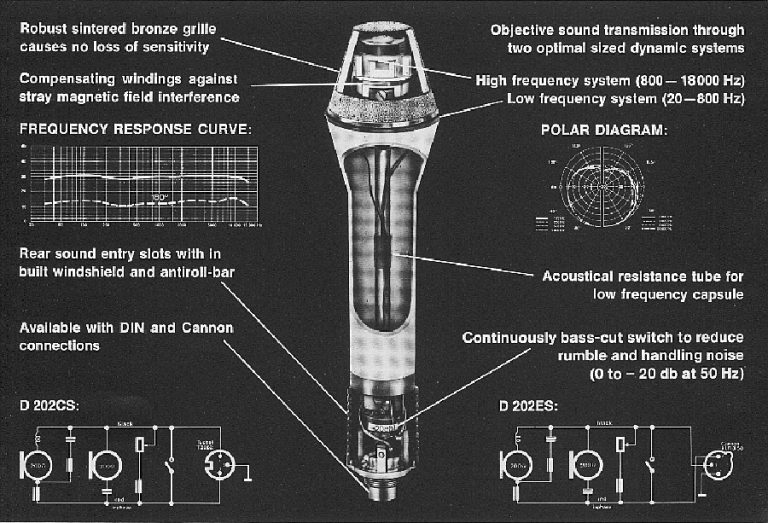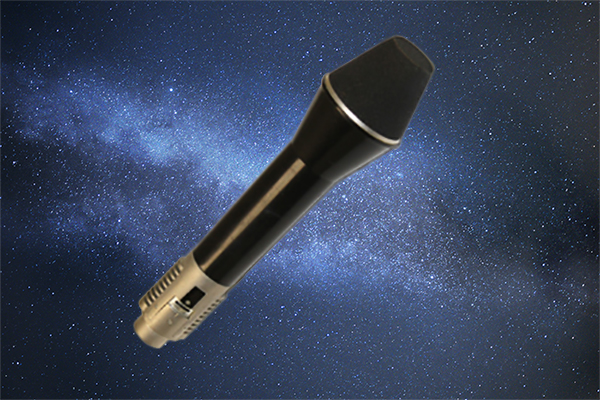The majority of old microphones in my collection are for display, largely because they’re, well, old. Some require repair, others need an unusual connector or cable assembly to function.
But the AKG D202E is different. It’s not in my working mic locker but I’ve employed it several times on stage, and may do so again, even though it’s the oldest AKG mic in my set.
The D202E is a cardioid dynamic handheld model with a twist—it employs two separate diaphragms, one for low frequencies and the other for high frequencies. The two signals are mixed together with a crossover network, with a full-range output signal sent down a standard XLR cable. The primary benefit is that there’s little to no proximity effect, while also providing an almost uniform directionality over the majority of its frequency range.
The diaphragms are shock mounted in the head of the unit. The HF portion is at the front and the LF is at the rear, surrounded by large ports, with sound traveling up an acoustic tube through the body of the mic to reach the element.

Opportunity Realized
The entity that would become AKG Acoustics was founded in 1945 when two friends, Dr. Rudolf Görike and Ernst Pless, realized that there was a business opportunity in providing equipment to a growing motion picture industry in the aftermath of World War II. Deliveries to customers in those early days were often made via bicycle or wheelbarrow, and the first transaction was bartered, with the partners receiving butter, fresh meat and cigarettes as payment.
They formed AKG (short for Akustische und Kino-Geräte Gesellschaft, which means Acoustic and Cinema Equipment in English) in 1947, and began the manufacture of light meters, automobile horns, telephone handsets, and of course, microphones. The early DYN Series of mics were popular with broadcasters as well as live users, and in 1949, the company introduced its first headphones, the model K120.
The D12, which debuted in 1953, was one of the world’s first high-quality cardioid condenser mics. It also led to the company modifying its logo—three overlapping omnidirectional polar patterns were replaced by three overlapping cardioid patterns, a design that’s still in use today.
Another innovation came in 1970 with the BX20, a portable studio reverb unit utilizing helix springs with long time delays that closely mimicked the reverberation characteristics of large concert halls. Four years later AKG was awarded its 1,000th patent. The company went public in 1984, introduced its first wireless microphone system in 1991, and by 1993, occupied a large, efficient production facility in the Vienna suburbs. Also in 1993, Harman International purchased a majority interest in AKG, and one year later, acquired the rest of the stock.
Distinct Style
AKG introduced the first 2-way cardioid microphones in 1966, including the model D202E. Company advertising at the time touted it as “especially suited for recording work in TV, motion picture and broadcasting studios” that was “recommended for picking up percussion instruments in front of loudspeakers.” The distinctive rear ports, resembling the fins seen on space rockets, led to the nickname of the “Sound Rocket.” (And that era was the “Space Age.”)

I haven’t tried any of those applications, but as noted, have utilized the D202E a few times, particularly for large symphony orchestras. With its flat, full-range pickup (even off-axis), it works quite well with string and horn sections, and does a nice job when applied for a harp. The lack of proximity effect is great for spoken word, but probably not optimum for a singing vocalist, especially one who works the mic close for extra low-frequency emphasis.
Another potential problem is the hand covering the rear ports, which could compromise the ability to pick up anything below 500 Hz or so.
The sintered bronze grille is rugged and acts as its own windscreen/pop filter. The body is made of a non-reflective black high-impact ABS polymer. The specification sheet notes, “Outdoor use, even in cold environments, is facilitated by the housing with low thermal conductivity.”
A 3-position bass roll-off switch offering 0, -7 and -20 dB positions at 50 Hz is located at the rear, to help reduce rumble and handling noise. Earlier versions were available with DIN and XLR connectors, with later units offering XLR only.
From a sonic standpoint, the AKG D202E is solid, especially considering how long ago it was designed. And it looks very cool, which is always a positive in my book. I’ll probably use it again with great results, particularly when I need to mike up a symphony.
AKG D202E Specs
Transducer Type: Dual non-metallic diaphragms, dynamic
Polar Pattern: Cardioid
Frequency Response: 20 Hz to 18 kHz
Sensitivity: -76 dB
Nominal Impedance: 500 ohms
Size: 8.6 x 2 inches
Net Weight: 11.3 ounces




















